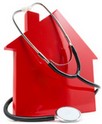


Environmental Risk Factors Contributing To Falls In The Home:
Between 25 and 75% of falls in older people involve an environmental component. Researchers have recognized a number of hazards in the home and public environment that contribute to falls and related injuries:
Stairs can be an issue - dangerous characteristics include excessively high, uneven, or narrow steps; stair edges not marked; slippery stair surfaces; discontinuous or poorly fitted handrails, and poor or excessive lighting.
Many factors in and around the home that contribute to falls include: loose or uneven rugs; lack of night lights; hard to find or reach light switches at room entrances; slippery shower stalls toilets or bathtubs (especially an absence of grab bars or handrails); appliance cords or other obstacles in walking routes; items stored in high cupboards; and low furniture such as beds or chairs. Outside hazards can include walkways that are cracked or slippery from rain, moss or ice; poor night lighting; even pets can create a tripping hazard.
Devices designed to assist mobility can help with independence and may prevent falls if maintained safely and correctly used. Remember though, that the tips of many canes can become worn, making them potentially unsafe. Some wheel chairs, or walkers with wheels, may lack a funtioning locking mechanism which can pose a hazard. Remember that having an assistive device does not necessarily guarantee its use. Many older individuals see such aids as symbols of their old age, and they may be reluctant to use them because of this stigma.
Home | Contact Us | Sitemap | Privacy Policy | Medical Alert Basics | Medical Alert Reviews | Submit A Review | Home Safety | Accident Prevention Independent Living Aids | Independent Living Advice
Copyright 2008-2010 Medical Alert Reviews
Copyright 2008-2010 Medical Alert Reviews


More Medical Alert Resources On MedicalAlertReviews.Com:
Medical Alert Basics
Special Features Of Medical Alert Systems
Guide To Independent Living
Home Safety
Preventing Accidents In The Home
Special Features Of Medical Alert Systems
Guide To Independent Living
Home Safety
Preventing Accidents In The Home
